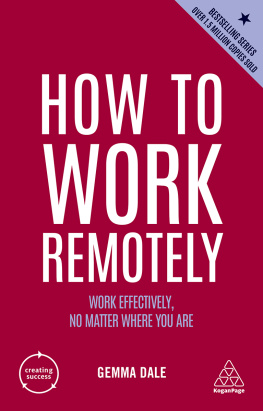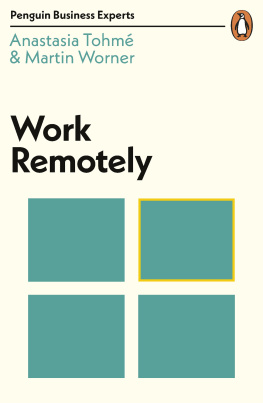Working Remotely
How to work from home with the best software to remain connected to your office (2020 Edition)
By
David Franco
Copyright 2020 by (David Franco) - All rights reserved.
This document is geared towards providing exact and reliable information in regards to the topic and issue covered. The publication is sold with the idea that the publisher is not required to render accounting, officially permitted, or otherwise, qualified services. If advice is necessary, legal or professional, a practiced individual in the profession should be ordered.
- From a Declaration of Principles which was accepted and approved equally by a Committee of the American Bar Association and a Committee of Publishers and Associations.
In no way is it legal to reproduce, duplicate, or transmit any part of this document in either electronic means or in printed format. Recording of this publication is strictly prohibited and any storage of this document is not allowed unless with written permission from the publisher. All rights reserved.
The information provided herein is stated to be truthful and consistent, in that any liability, in terms of inattention or otherwise, by any usage or abuse of any policies, processes, or directions contained within is the solitary and utter responsibility of the recipient reader.
Under no circumstances will any legal responsibility or blame be held against the publisher for any reparation, damages, or monetary loss due to the information herein, either directly or indirectly.
Respective authors own all copyrights not held by the publisher.
The information herein is offered for informational purposes solely, and is universal as so. The presentation of the information is without contract or any type of guarantee assurance.
The trademarks that are used are without any consent, and the publication of the trademark is without permission or backing by the trademark owner. All trademarks and brands within this book are for clarifying purposes only and are the owned by the owners themselves, not affiliated with this document.
Table of Content
Introduction
Remote work also called a telecommuting work, maybe either entirely distant or partially inaccessible. Some of these jobs can be performed entirely from home or another place, while others can need a couple of days at the office. Remote jobs have found in a whole range of industries, from technology to customer service and design. Technological advancements in computing resources and networking technologies make it easier for people to get a remote job every day.
It doesn't always mean they work remotely. When travelling, it does not always imply jobs either. Remote work has a vast spectrum and can be incredibly flexible. Some people can combine this working style with a few days in the office, while others will probably never even face to face meeting with their colleagues.
Some people may think they already have a clear understanding of what it is, but in fact, the concept can be very vague, the remote work allows professionals to work outside fixed office space.
Remote work certainly is on the rise. It is worth learning all the different ways it might suit you, and taking advantage of everything it has to offer. Perhaps you're the most active at night, rather than an early bird. With remote work, you're free to decide as to how and when you accomplish your assignments. You can choose your style of work, as long as you reach the deadlines. It's easy to see why it's increasingly becoming a simplified arrangement for employees around the world.
Even employers begin to understand why remote work can be useful to a firm. Cutting on office expenses, a more satisfied workforce and also increases in efficiency are all attractive benefits to have. With technology making keeping in touch and working outside the workplace much easier, remoting is making headway in the job world.
Not every remote job needs you to be there full time. There are also freelancing and part-time remote jobs, ranging from a few hours a week to one-off job. Not everyone works even from home. Some at the same time, take the opportunity to travel and work, living the life of a digital nomad. One day, they can work at some exotic location from the beach, and then jet off somewhere else next. Telecommuting provides much greater independence, especially for those without geographical connections. Making good use of technology and keeping the internet mobile always gives us the physical component!
"Working from my home is worth a hundred thousand dollars just on its own - because of the freedom and because of the time-saving."
A member of Chess.com
Chapter 1: The Concept of Remote Working and its Benefits
1.1 Introduction to Remote Working
Facts about remote work help increased efficiency and business results. Efficiency has been shown to improve telecommuting, allowing for more efficient work and fewer interruptions. This gives the workers more control of their time and resources. This also promotes greater work-life balance and childcare plans by reducing the commute.
That kind of versatility requires workers, and this is what drives efficiency. In fact, 29 per cent of remote employees say they're happier than on-site workers, and when asked why they're claiming higher productivity and less tension. That is further borne out by decades of Gallup studies showing "when workers are engaged their performance soars: highly engaged workplaces can report 41% lower absenteeism, 40 % lower quality failures and 21% higher productivity."

Nevertheless, if you are not used to remote work, the involvement of family members can be daunting, with a lack of dedicated space and the absence of direct supervision. It might help to note that 18 per cent more executives work remotely than on-site, and many of them are probably both in your field and have a common professional experience. The U.S. workforce, after all, is nearly 5 million strong, with telecommuting executives, consultants, employees and administrators in hospitals, banking, education, manufacturing, technology and many other fields.
Apart from the industry, all productive remote businesses are rooted in trust: the employer needs to be sure that the workers can do the jobs they were hired to do, and well. Remote job is, by definition less about face time and more about achieving or exceeding targets. Managers create trust by making priorities clear, providing the support and resources workers need to get work done, and identifying where employees stand out. This will be sounding like a tall order to the remote manager beginner, but break it down, and you will know that these are the same items that you personally give to your employees. With remote work, the only difference is that some of your communication methods may shift.
The Virtual Stand-Up Session
Stand-up meetings are an ideal way to get the business day underway. The team members will exchange information, get-togethers, create camaraderie, get feedback and ask questions using platforms such as Zoom, Google Hangouts or Skype.
The format is relatively basic. Provide five minutes for every team leader or department to share. People usually End their time with a simple amount of request or provide the assistance they may need to complete an assignment. Leave time for a free, unstructured chat at the start or end to give the time for the team to catch up.
Decide how often you wish to check in with your team once the process has been established. Do you have to hold meetings every day, three times a week or just once on Fridays? When is it most beneficial to give status reports or plan a response to events you haven't anticipated? It will then become the focal point for the virtual teams in the new communication process.














